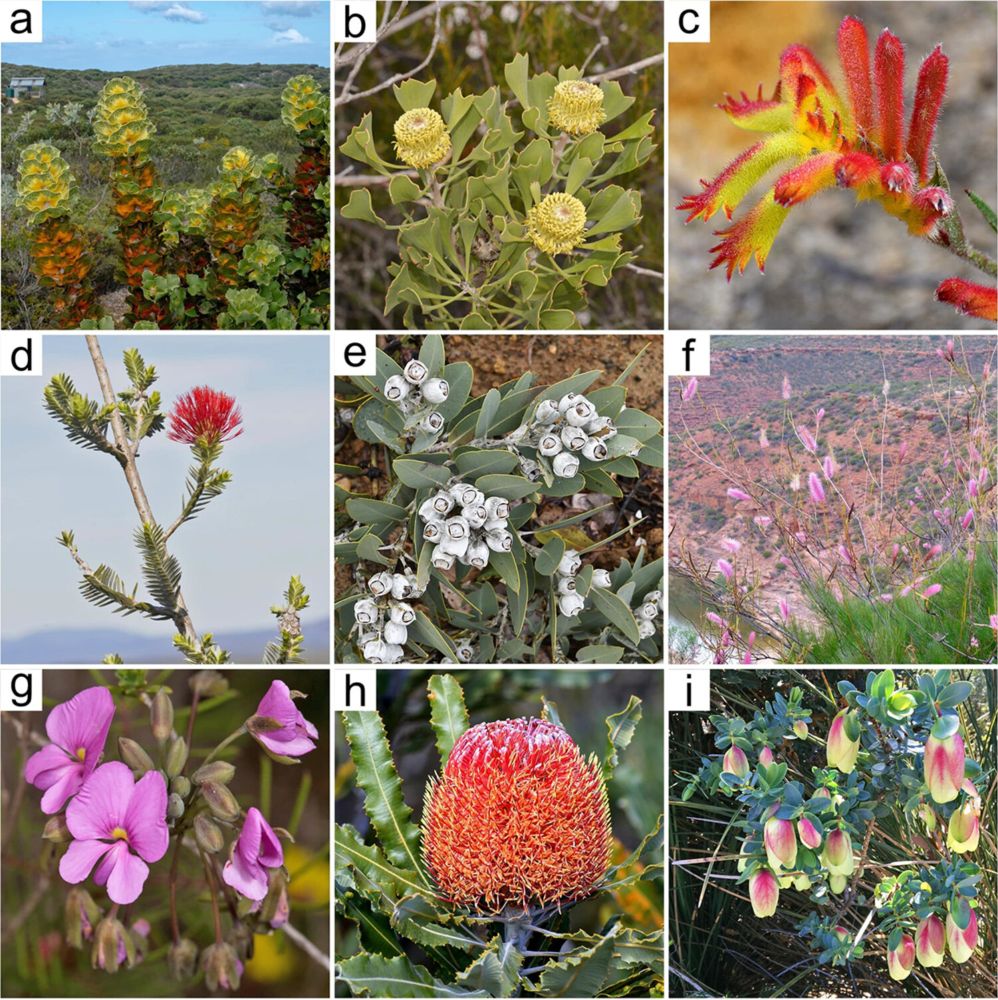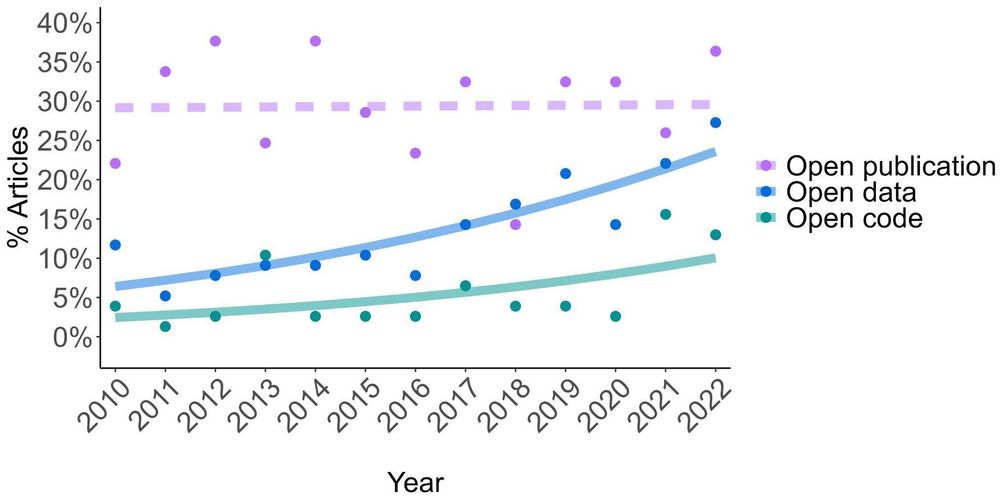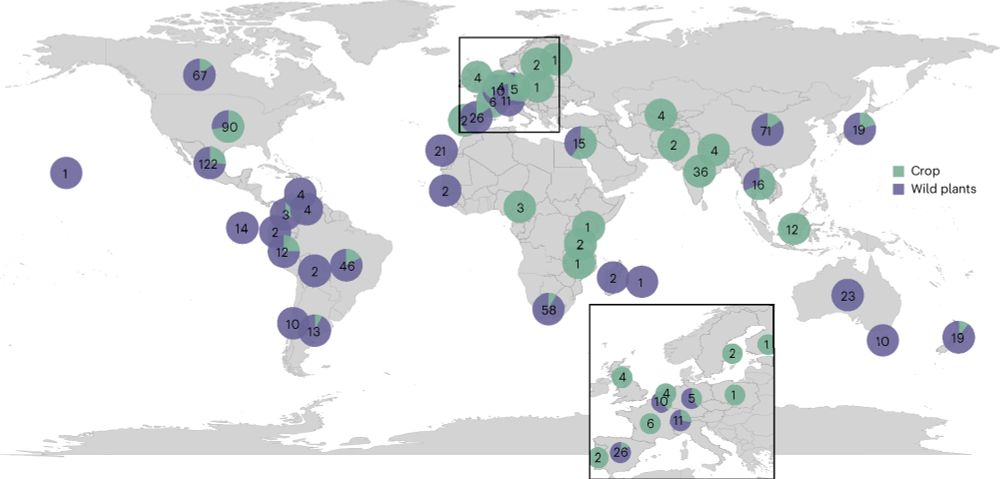'Hello human, nice to meet you'
23.07.2025 20:24 — 👍 27124 🔁 4218 💬 751 📌 465
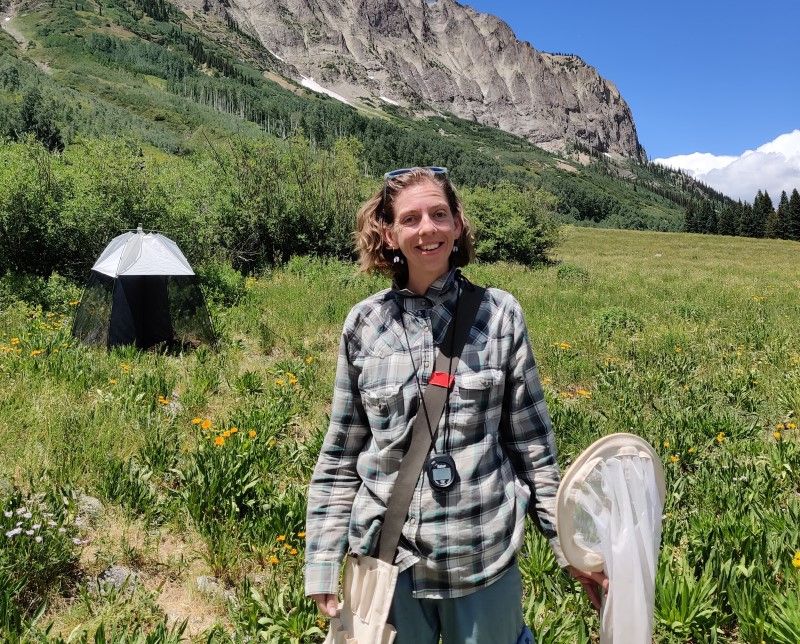
In part two of our #BiologyLetters #ECR Competition series, we speak with Ruby Stephens, the runner-up of the 2024 competition, about her research paper: Zygomorphic flowers last longer: The evolution of floral symmetry and floral longevity. ow.ly/tRWt50V2BrO @rubyecology.bsky.social
19.02.2025 10:36 — 👍 6 🔁 2 💬 1 📌 0

Giant 400-year-old tingle tree accidentally destroyed by authorities
WA officials have defended the state's prescribed burning strategy after an enormous tingle tree was destroyed in a recent fire.
Widespread planned burning accelerates loss of large trees and locks in higher flammability for decades. There are alternatives that the Western Australian government should invest in. Check the video featuring fire expert Phil Zylstra🌏
www.abc.net.au/news/2025-01...
13.01.2025 20:43 — 👍 35 🔁 23 💬 2 📌 0
Excellent news to start the new year on, thanks @royalsocietypublishing.org !
13.01.2025 20:48 — 👍 10 🔁 0 💬 0 📌 0
I've just moved back to the blue mountains as an adult, and have spent a lot of time going "wow I never paid attention to how beautiful this all is"
My teenage stepdaughters are less thrilled by all the bush and quiet though 😅
12.01.2025 20:19 — 👍 2 🔁 0 💬 0 📌 0
Great shirt!
17.12.2024 08:52 — 👍 1 🔁 0 💬 1 📌 0
Nice shot! Honey bees are somewhat controversial pollinators in Australian ecology, but they're definitely good on the lemon tree 🍋
16.12.2024 06:39 — 👍 1 🔁 0 💬 1 📌 0
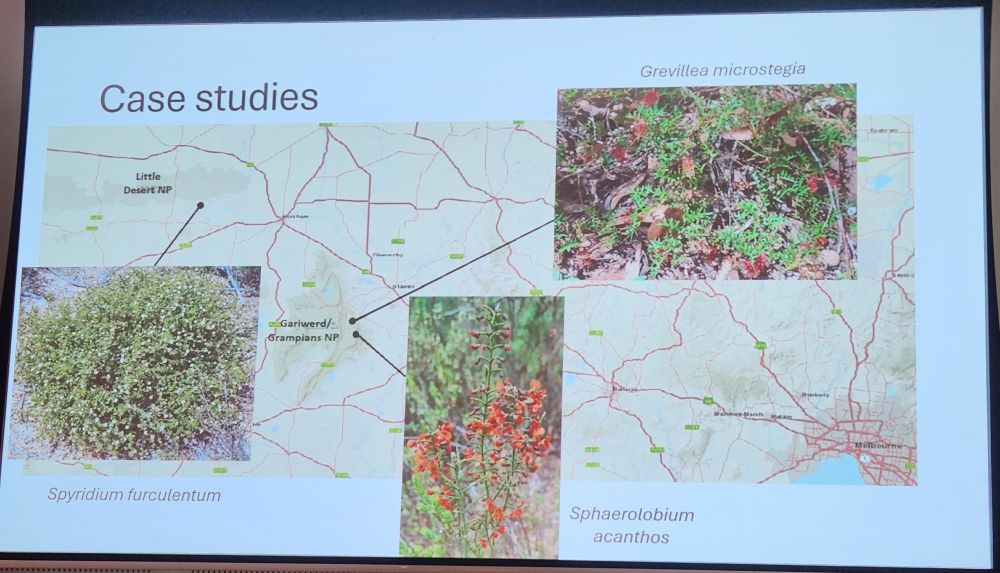
Photo of a slide showing a map of western Victoria, with photos of three rare plant species and their approximate distributions in Grampians NP and Little Desert NP. The species, all shrubs, are Spyridium furculentum, Sphaerolobium acanthos and Grevillea microstegia
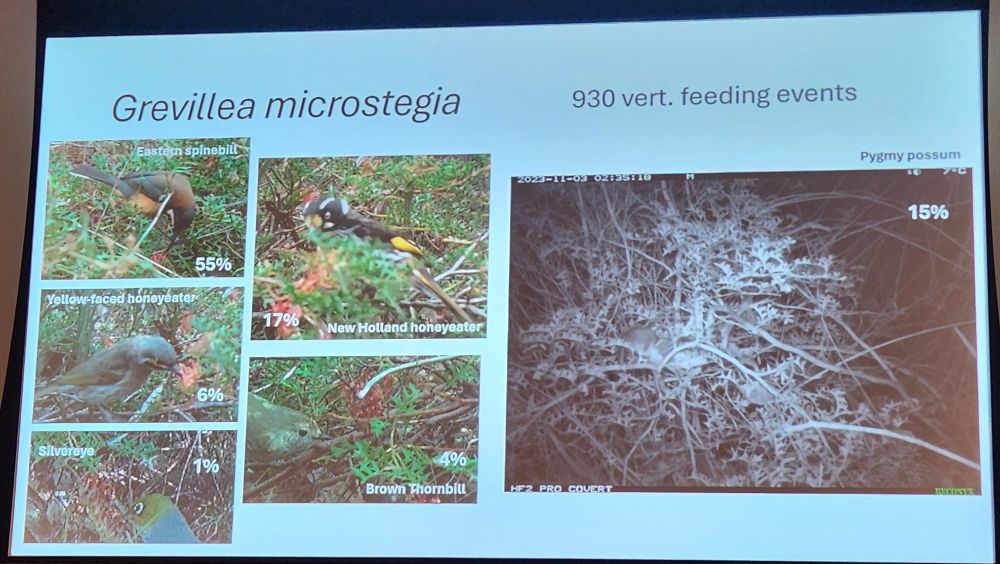
Photo of a slide entitled "Grevillea microstegia", with images of the many vertebrate pollinators found visiting this plant's flowers, including the eastern spinebill (55% of visits), new holland honeyeater (17%), pygmy possum (image in black-and-white as taken at night, 15% of visits), yellow-faced honeyeater (6%), brown thornbill (4%), silvereye (1%)
Linda Riquelme highlighted that pollination can be key to plant translocation success.
She investigated pollination in three critically endangered shrub species, all of which depend on pollinators to set seed. Pollinators = 🐝 (S. aca), 🐦🐿️ (G. mic) and 🪲🪰🦋 (S. fur)
#ESAus2024 🌏🧪
16.12.2024 05:40 — 👍 3 🔁 0 💬 0 📌 0
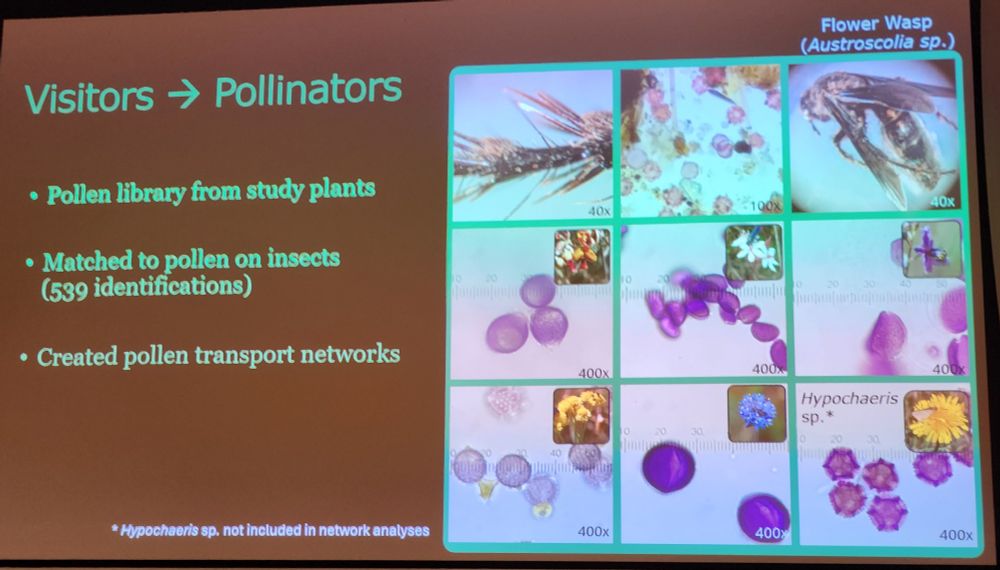
A photo of a slide entitled "Visitors -> Pollinators", with bullet points that state "pollen library from study plants", "matched to pollen on insects (539 identifications)", "created pollen transport networks". Images on the right hand side of the slide show close up photos of a pinned Flower Wasp specimen (Austroscolia sp.) bearing a mix of pollen grains. Other images show pollen grains from 5 native and 1 non-native plant species, with the clarification that the non-native species (Hypochaeris sp.) was not included in network analyses
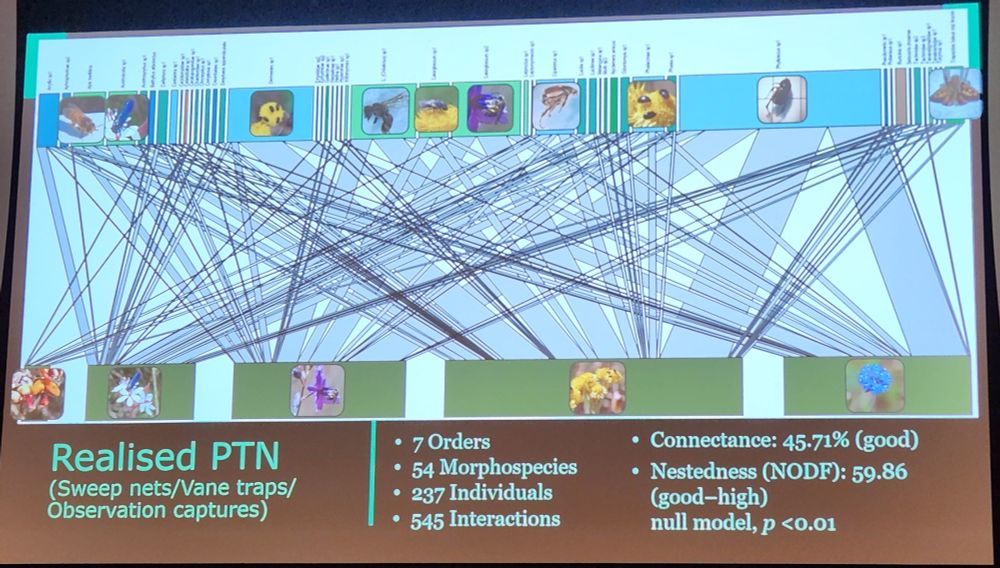
A slide showing a bipartite pollination network, with insect pollinator morphospecies on the top and flowering plant species on the bottom. Text below the network states that 545 interactions were detected overall, with 237 individuals from 54 morphospecies of insects in 7 orders (and 5 flowering plant species), with high connectedness in the network
Allison Menzies @invertally.bsky.social spent 8 weeks sampling pollination networks in a Victorian grassland.
Though field conditions weren't great (lots of rain) she still found a decent network with lots of connectance, few honey bees and a lot more flies visiting than pollinating
#ESAus2024 🌏🧪
16.12.2024 04:48 — 👍 5 🔁 0 💬 1 📌 0
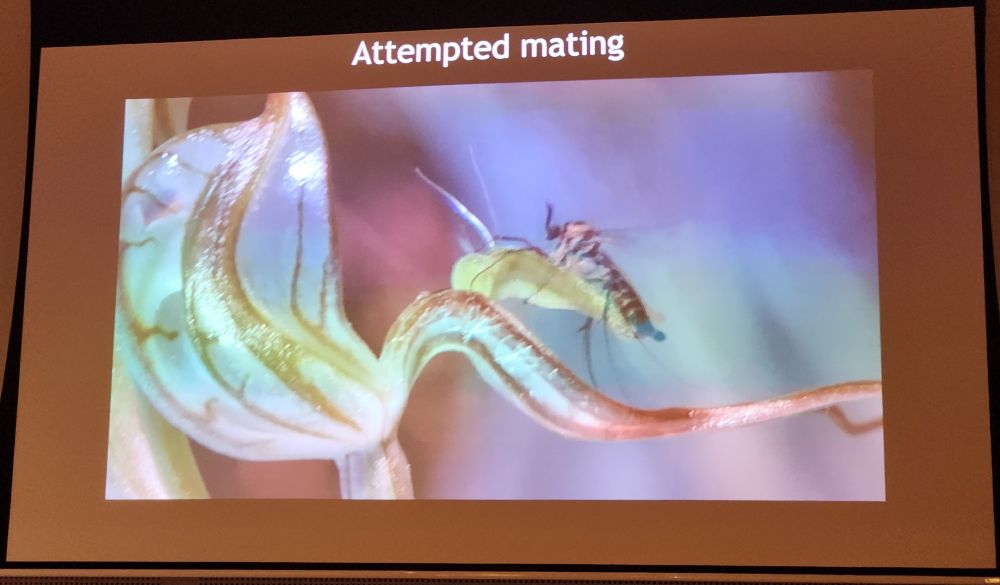
Photo of a slide showing a Xenoplatyura conformis fungus gnat attempting to mate with the labellum of a 'rustyhood' Pterostylis orchid. For pollination to be successful the labellum should trigger and capture the fungus gnat
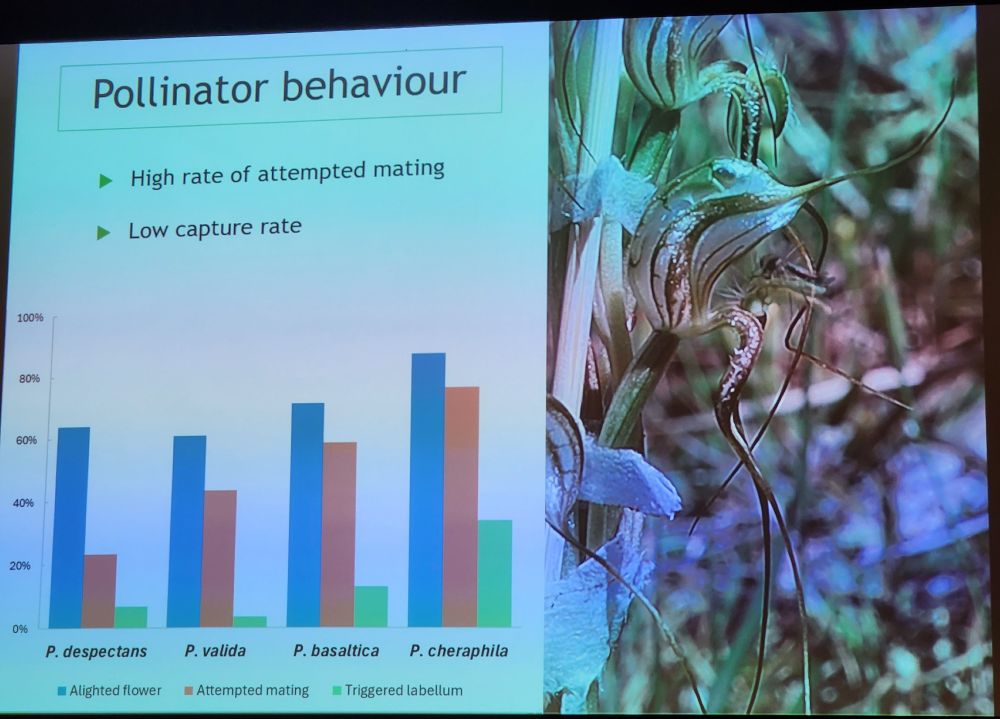
Photo of a slide with the title "Pollinator behaviour", and bullet points "high rate of attempted mating" and "low capture rate". A graph shows that, for four species of Pterostylis orchid, more fungus gnat pollinators alighted on the flower and attempted mating than triggered the labellum (necessary for pollination to occur). An image on the left shows one species of Pterostylis with a visiting fungus gnat
Eamonn Culhane investigated pollination in 4 species of arid Pterostylis orchids (rustyhoods).
Despite sharing a widespread fungus gnat pollinator, these sexually deceptive orchids rarely set seed - perhaps because they rarely succeed at capturing their amorous gnat visitors
#ESAus2024 🌏🧪
16.12.2024 04:17 — 👍 4 🔁 0 💬 1 📌 0

A slide showing bright pink flowers of Eremophila maculata with flower parts labelled with botanical terms
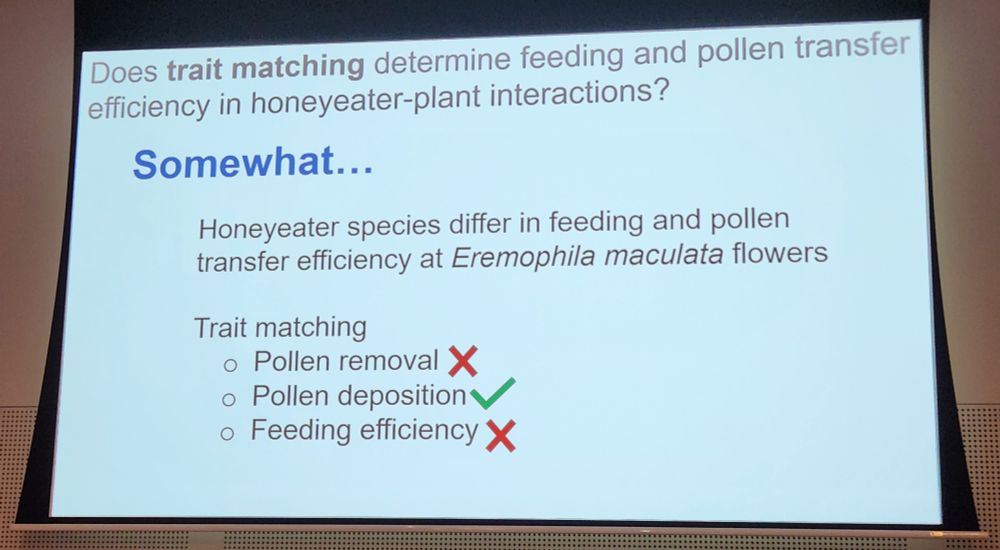
A slide posing the question, "Does trait matching determine feeding and pollen transfer efficiency in honeyeater-plant interactions?" and answering this question with "Somewhat... Honeyeater species differ in feeding and pollen transfer efficiency at Eremophila maculata flowers. Trait matching: pollen removal (cross); pollen deposition (tick); feeding efficiency (cross)
Okay some belated highlights from pollination talks at #ESAus2024 :
Amanda Hewes ran behavioural experiments to test trait-matching between Australian honeyeaters and Spotted Fuschia-bush. Results? A bit mixed - some matching between bill and corolla length for pollen deposition but not removal
🧪🌏
16.12.2024 03:29 — 👍 2 🔁 1 💬 1 📌 0
A DnD campaign for environmental educators! So cool 🤓
13.12.2024 21:03 — 👍 14 🔁 4 💬 0 📌 0
Doesn't load for me (Australia)
13.12.2024 08:58 — 👍 1 🔁 0 💬 1 📌 0
🖐️🙏
13.12.2024 06:29 — 👍 1 🔁 0 💬 0 📌 0
Oh I love the cockatoos!
13.12.2024 05:52 — 👍 1 🔁 0 💬 1 📌 0
Yeah the low richness in India does seem weird. This richness is only from described ant species- is it possible India has a lot of undescribed ant species?
12.12.2024 12:02 — 👍 0 🔁 0 💬 1 📌 0
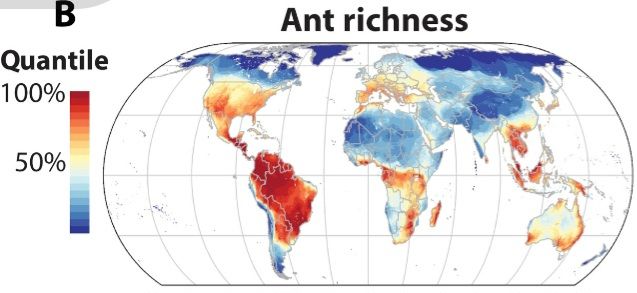
Map of ant richness globally from Kass et al. (2022) Science. Northern Australia doesn't look very species rich but this may be because of a large number of undescribed species
Fabulous address by @ecolsocaus.bsky.social Gold Medal winner Alan Anderson at #ESAus2024 on ant biodiversity in Australian savannahs - which may be much higher than pictured in this map due to a large number of undescribed Australian ant species!
12.12.2024 05:58 — 👍 10 🔁 0 💬 1 📌 1
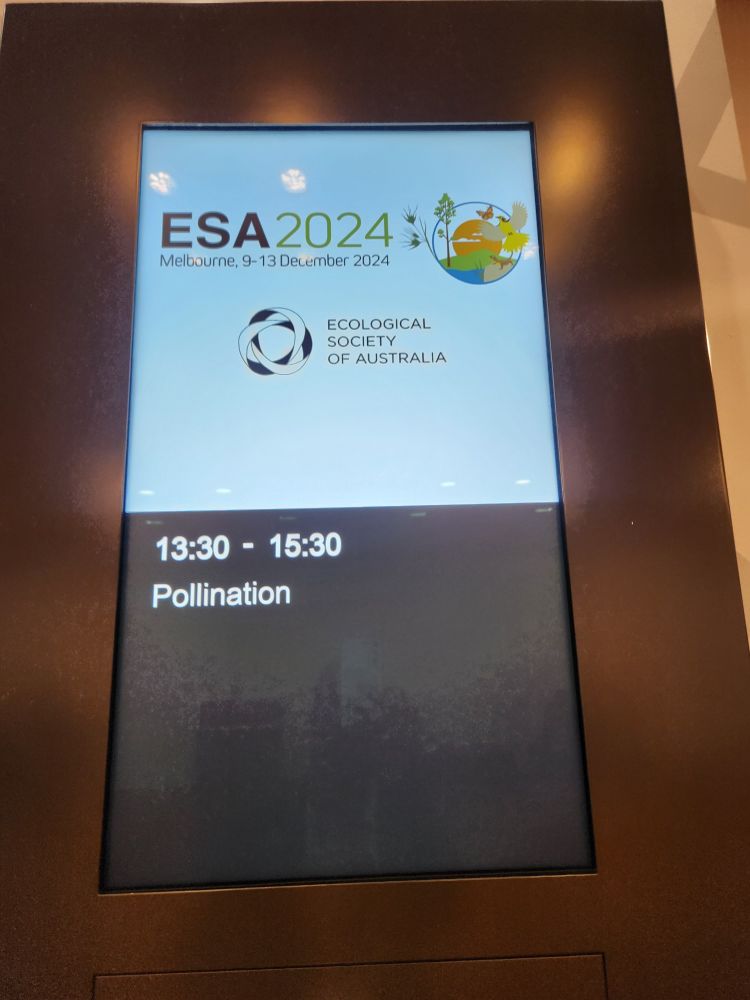
Excited for a room full of (Australian) pollination talks! #ESAus2024
12.12.2024 02:31 — 👍 28 🔁 0 💬 2 📌 0
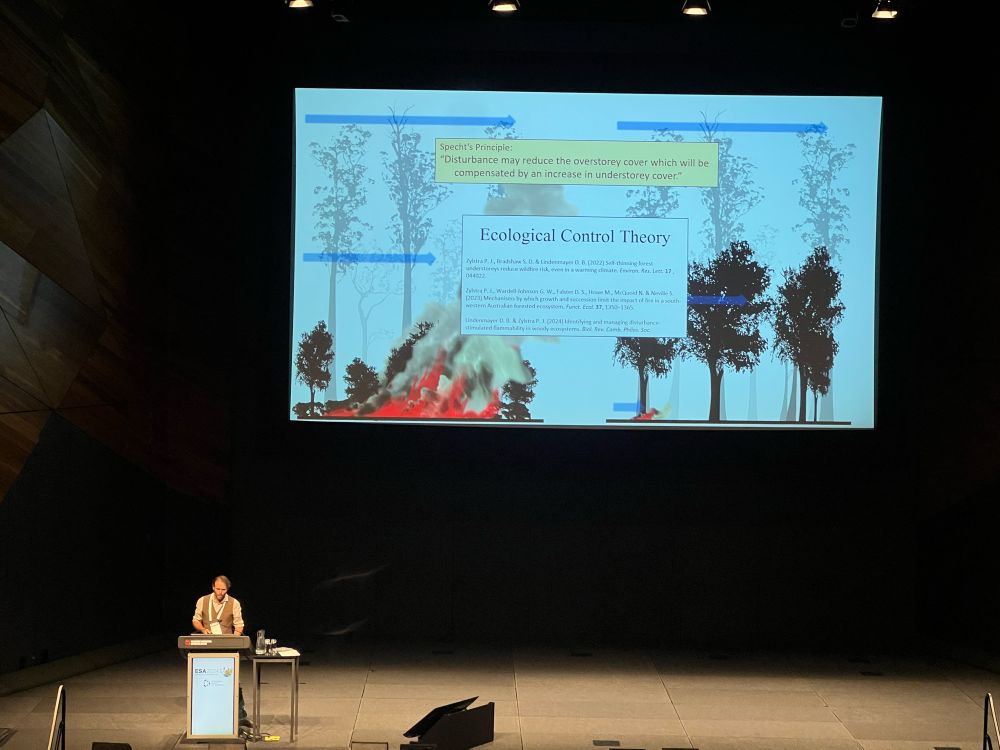
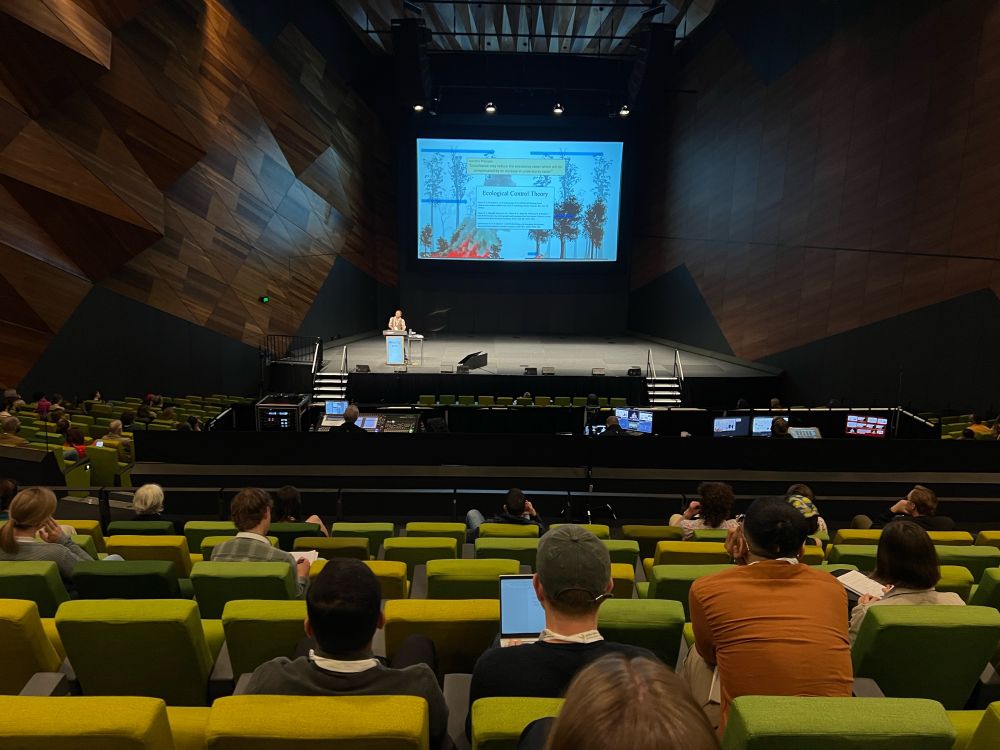
Today’s opening plenary at #ESAus2024 by @philzyl.bsky.social urges us to look deeper & not simply accept the dominant dogma that more fuel load means higher rate of spread. Tall biomass can calm the fire by slowing wind. We need to learn from deep Indigenous knowledge to better manage our forests.
10.12.2024 22:39 — 👍 18 🔁 4 💬 0 📌 0
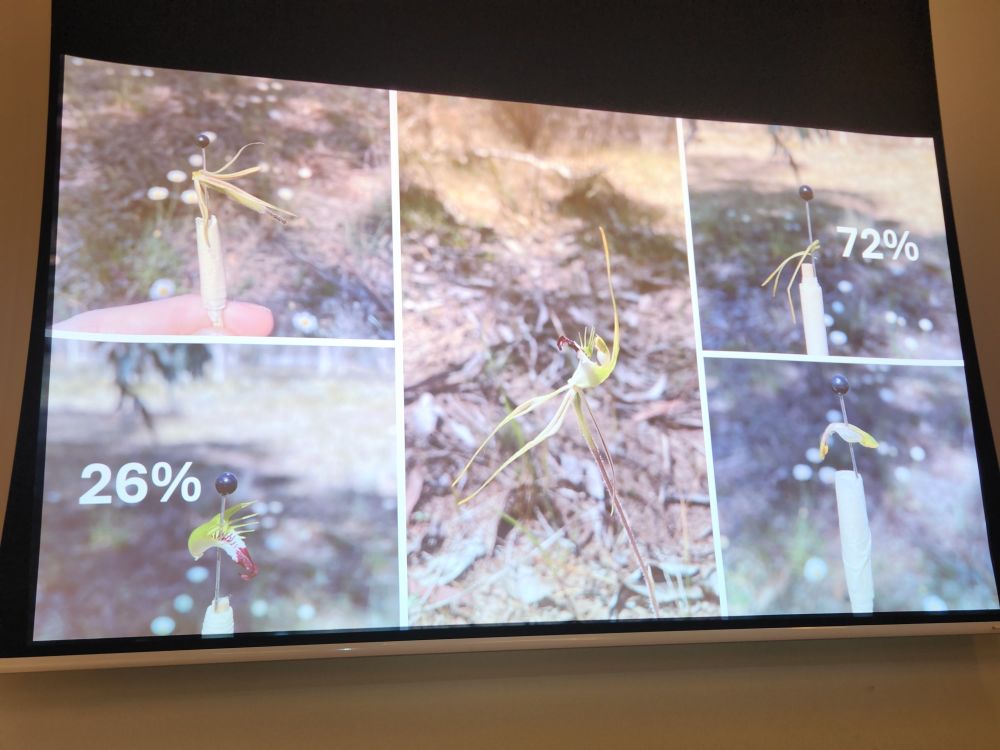
Delightful to see an orchid nerd butcher an orchid- for science!
I loved Andrew Bird's method for figuring out what part of the Caladenia flower smells most attractive to pollinators #ESAus2024
10.12.2024 11:02 — 👍 12 🔁 1 💬 0 📌 0
Second day of #ESAus2024 and we have 60 people in the conference starter pack. Follow other austral ecologists, ask to join the list, and maybe even share the link with people who need a little encouragement to come over to Blue Sky.
#StarterPack 🧪🌏🇦🇺
go.bsky.app/5YmZLNm
09.12.2024 20:04 — 👍 24 🔁 12 💬 0 📌 0
Thank you!
09.12.2024 10:57 — 👍 1 🔁 0 💬 0 📌 0
Thanks for organising this! I'm here too if you can add me :)
09.12.2024 10:49 — 👍 1 🔁 0 💬 1 📌 0
Ooh thanks Hervé!
01.12.2024 04:09 — 👍 0 🔁 0 💬 0 📌 0
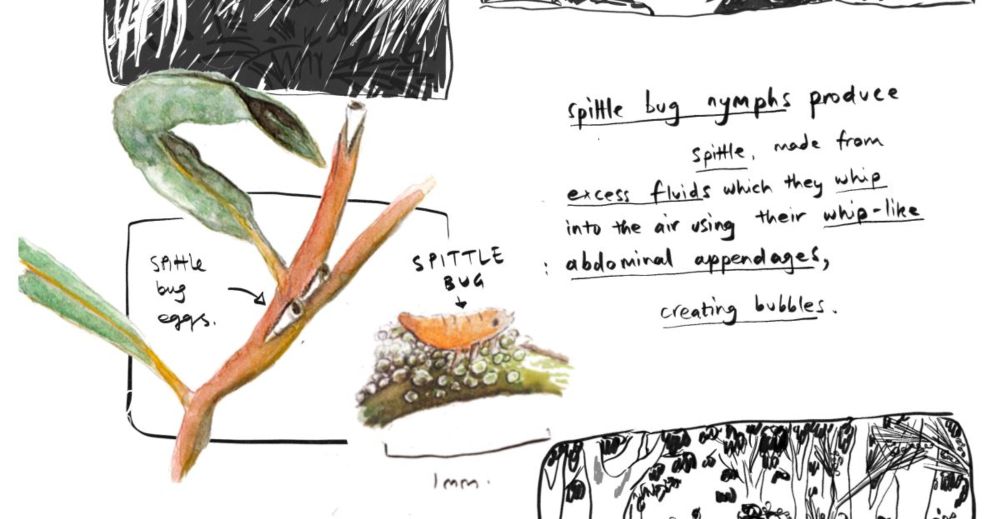
So much to tell you: or, piercing plant tissue with needle-like mouth-parts - Overland literary journal
Looking for things meant I could enjoy the feeling in my body. Something like hope, or friendship.
In her latest, beautiful comic, Sofia Sabbagh goes in search of forest critters, from the graciillaridae to the psyllids. Generously sponsored by @copower.bsky.social.
27.11.2024 01:12 — 👍 12 🔁 4 💬 0 📌 1

Floury baker cicada conveniently posing beside a ruler for scale (may have been set up)
Hard to go outside without earplugs right now thanks to these cutie cicadas and their many cousins #WildOz
25.11.2024 02:14 — 👍 43 🔁 7 💬 1 📌 1
Ecology researcher
Interested in pollinator ecology and wild bee taxonomy
The life and times of Steve the otter...
We are scientists who agree with Extinction Rebellion that it is time to take direct action to confront catastrophic climate and ecological breakdown.
We are predominantly UK-based.
https://www.scientistsforxr.earth/
Award-winning science communicator, bestselling author, TV personality & co-founder of Scientists for XR - making STEM fun, fighting misinformation & advocating for diversity.
AuDHD, she/her
2x TEDx speaker, 4x cat lover
www.emilygrossman.co.uk
Equollogist in training | PhD candidate @UTAS based in Lutruwita|Tasmania researching eastern quoll translocations | quoll pun and small mammal enthusiast 🐀
she/her 🏳️🌈
Quantitative ecologist, conservation & population dynamics. EcCo lab PI. Assoc Prof at Uni. of Reading, UK. She/her.
https://sites.google.com/site/manuelagonzalezsuarez/Home
Ecologist and PhD candidate at UNSW Centre for Ecosystem Science with a particular interest in birds.
I’m campaigning for more messy spaces for nature, join our messy mission and let’s Rewild together by doing less- and letting nature do the rest!
PhD researcher - Rewilding with Beavers 🦫
Founder of the Wee Pond Project 🐸
Digitising Australia's biodiversity heritage literature to provide free #openaccess online (the Australian branch of @biodivlibrary.bsky.social; a collaboration with the Atlas of Living Australia @csiro.bsky.social).
Provide nature/travel photography and fine art prints, using photography to raise awareness and promote conservation of the natural world.
kandpphotography.com.au
I’m a wildlife ecologist at Deakin University Australia. Long-term small mammal, fire and climate research in Gariwerd (Grampians). Rodenticide impacts in wildlife. Urban ecology. Powerful owls. Native gardener :)
Interested in applied statistics and meta-science
🧬🌿 | Birds | Fish | My Cat
A PhD student with the Botanic Gardens of Sydney and USyd. Working on genetics behind Myrtle rust and paperbarks for restoration.
Tldr: #wetlands #plantdisease #genetics #botany #restoration #ecology
Communicating science and data, I illuminate the interconnectedness of climate action, biodiversity conservation, and energy policy. I translate complex information into clear narratives to drive informed decisions for sustainable solutions.
Science Communication - Journal Manager (CSIRO Publishing) - PhD in Plant Biochemsitry (University of Melbourne) - Sport (AFL, Cricket, Rugby, Football)
I write about climate change for @opinion.bsky.social and pursue the outdoors
she/her - 🌾🏳️🌈🌾
Plant Toucher
An international journal publishing original contributions to the field of plant science with relevance to Southern Hemisphere ecosystems. #AusJBotany https://www.publish.csiro.au/bt
News, events and the latest research from the School of BEES, University of New South Wales - www.unsw.edu.au/science/our-schools/bees

